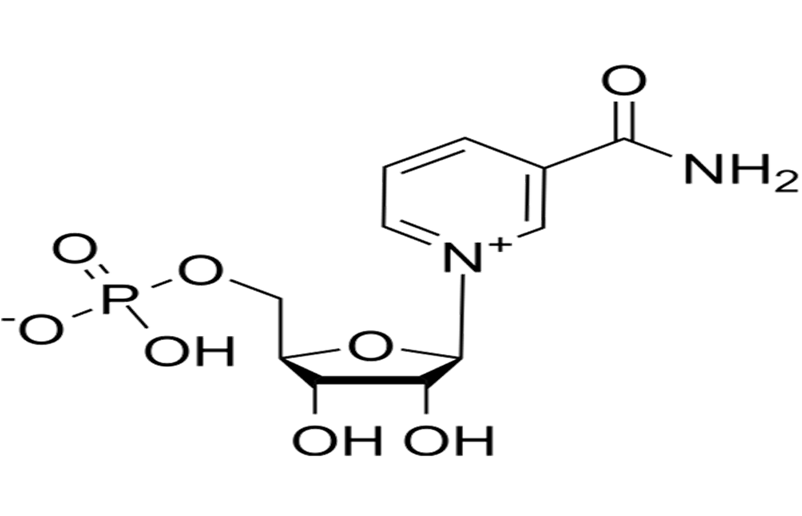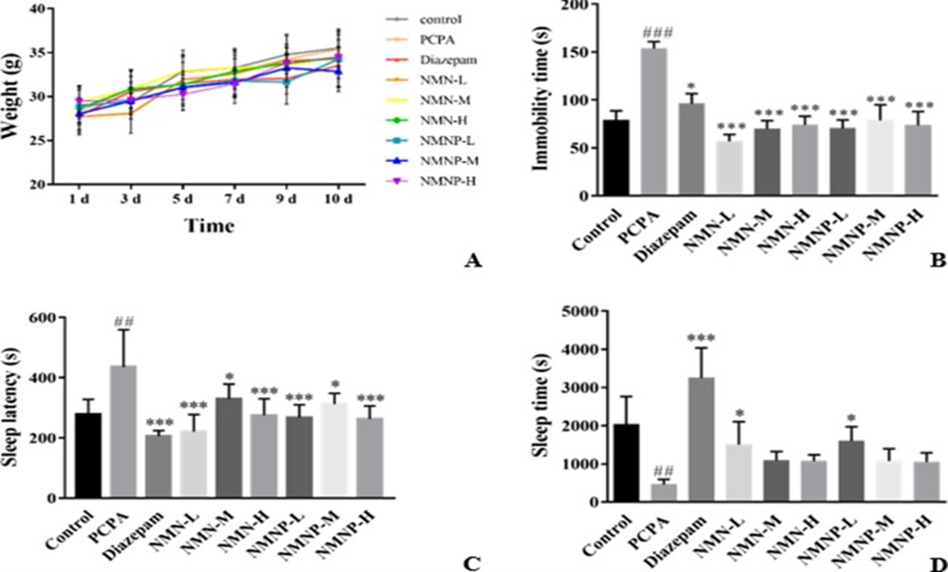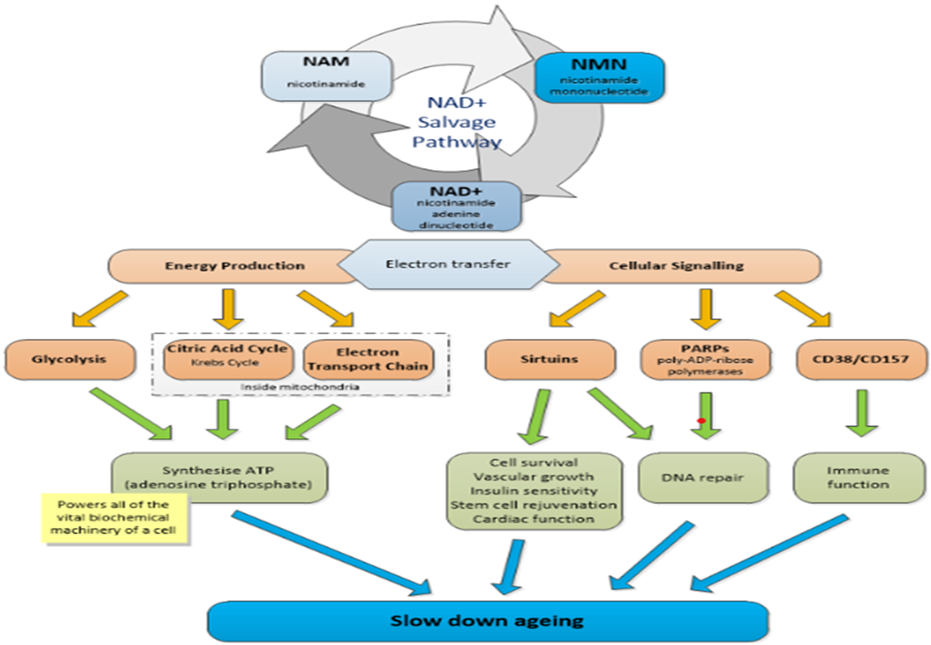β-Nicotinamide mononucleotide
With respect to longevity and enhanced health, scientists have turned their attention towards a remarkable molecule: Beta Nicotinamide Mononucleotide (NMN). It’s a derivative of Vitamin B3 (niacin), has gained attention for its potential to modulate cellular function, combat the aging, and promote overall well-being. β-Nicotinamide mononucleotide (NMN) is a natural product which exists in small quantity in most plants, such as edamame, broccoli, and cucumber. It is endogenous molecule in all mammalian tissues. Its biological functions are linked to the ability to boost nicotinamide adenine dinucleotide (NAD) . NAD concentration declines with age affecting mammalian longevity and age-related health conditions through its functions of energy metabolization and activations of poly ADP-ribose polymerase (PARP), Sirtuin proteins, and etc. in mammalian tissues.

Figure 1: Shows the structure of beta nicotinamide mononucleotide
NMN and NMNP alleviate depression-like behaviors and for it’s observation we treated mice with these compounds and analyzed that NMN and NMNP treatment at 300, 400 and 500 mg·kg−1 and we noticed it did not cause significant changes of body weight in PCPA-induced mice, so It was suggested that NMN and NMNP probably had no toxicity on mice. It is revealed that PCPA injection resulted a marked increase of immobility time in mice compared with that in the control group. However, the immobility time was markedly recovered to the basal level by NMN and NMNP treatment for 7 days. For example, the minimum immobility time in NMN-L and NMNP-L-treated group was determined to be 56.83 ± 17.61 and 70.17 ± 22.12 s, respectively, which was even shorter than that in the control group (79.00 ± 24.05 s). These data strongly suggested that NMN and NMNP treatment alleviated the depression-like behavior of insomnia mice.

Figure 2:NMN and NMNP alleviate depression-like behaviors
Fig 2 Effects of NMN and NMNP treatment on body weight (A), immobility time (B), sleep latency (C) and sleep time (D) in PCPA-induced insomnia mice. ## P < 0.01 and ### P < 0.001 compared with the Control group; * P < 0.05, ** P < 0.01 and *** P < 0.001 compared with the PCPA group.
Β-Nicotinamide Mononucleotide Alleviates Hydrogen Peroxide-Induced Cell Cycle Arrest and Death in Ovarian Granulosa Cells : The dysfunction of GCs impairs nutrition supply and estrogen secretion by follicles and negatively effects the breeding capacity of farm animals. GCs impairment is associated with declines in Nicotinamide adenine dinucleotide (NAD+) levels, which triggers oxidative stress, and the oxidative stress then attacks the subcellular structures and cause cell damage. Several studies confirmed that Β-nicotinamide mononucleotide (NMN), a NAD+ precursor, has well-known antioxidant properties . In one study, using two types of ovarian GCs (mouse GCs (mGCs) and human granulosa cell line (KGN)) as cell models researchers aimed to investigate the potential effects of NMN on gene expression patterns and antioxidant capacity of both mGCs and KGN that were exposed to hydrogen peroxide (H2O2) . By the functional enrichment analysis revealed that DEGs were mainly enriched in key pathways like cell cycle, senescence, and cell death. Using RT-qPCR, CCK8, and β-galactosidase staining, they found that H2O2 exposure on mGCs reduced cell activity/mRNA expressions of antioxidant genes, inhibited cell proliferation, and induced cellular senescence. Notably, NMN supplementation partially prevented these H2O2-induced abnormalities. Moreover, these similar beneficial effects of NMN on antioxidant capacity were confirmed in the KGN cell models that were exposed to H2O2. NMN Supplementation Shapes the Gene Expression Pattern in mGCs That Are Exposed to H2O2 : Researchers conducted a principal components analysis (PCA) among group C (control), group H (150 μM H2O2), and group HN (150 μM H2O2 + 500 μM NMN). According to the analysis, the first principal component (PC1) and the second principal component (PC2) accounted for 83.3% and 10.5%, respectively. Moreover, the contribution of PCA to the sample difference was more than 93%, which could represent clear differences among different conditions (Figure 1A). Meanwhile, RNA-seq analysis results showed that the distance was relatively close between group H and HN, which indicate that NMN could partly recover the gene expression in H2O2-cultured mGCs. The cluster analysis also showed that group C significantly differed from group H and group HN and suggested that the gene expression pattern in mGCs were affected by H2O2 or NMN (Figure 1B).

Figure 3 : Shows the effects of NMN supplementation on the gene expression pattern of mouse granulosa cells that are exposed to hydrogen peroxide.
NMN produces NAD by various processes, and has health benefits. Low levels of NAD can lead to chronic disease and aging and reduces quality of life. Ageing can reduce our overall quality of life. It can make us feel weak and powerless. NMN helps you turn back the clock and fight this brutal process. NMN can help boost your metabolism. Over time, a bad lifestyle, diet, or other factors can lead to our gene expression defects. Thus when genes are altered, which can cause several serious diseases. Diseases caused by changes in gene expression are neurological disorders, diabetes, and cancer. These can often be incurable and may cause lifelong suffering. NMN helps in repairing the DNA to keep any such diseases away. Trials on mice have been made and proved to be successful .People affected by this degenerative disorder only seems to be growing. NMN helps lower the production of harmful chemicals in the brain, that cause Alzheimer’s. This prevents degeneration of the brain and maintain health. Additionally, NMN also keeps the brain healthy apart from keeping away from the Alzheimer . It helps keep the synapses running so that we don’t experience mental ability loss as we age. NMN works at a very low level in the body’s metabolism. NAD switches between its two forms, NAD+ and NADH, by accepting electrons (for example from food) and donates these electrons to other processes, Thus supporting many other crucial reactions in the cell that enable energy production and cellular signaling. NAD+ helps to produce ATP via glycolysis, the citric acid cycle and the electron transport chain (inside mitochondria). Most cells in the body use approximately one billion ATP molecules every minute – so if there isn’t enough NAD around to replenish the production your cells start to die. That’s why NMN as a NAD booster, which increases energy metabolism. NAD plays an important role in cellular signaling. One of the most critical is the maintenance of sirtuins which are involved in coordinating an array of crucial functions such as blood vessel growth, stem cell rejuvenation and DNA repair. Beta Nicotinamide Mononucleotide (NMN) represents a promising avenue for enhancing health and longevity. By boosting NAD+ levels, NMN can improve cellular function, support DNA repair, and promotes overall well-being. As research continues to unveil the full potential of this extraordinary molecule, NMN supplementation may become a milestone of anti-aging and health optimization strategies.

Figure 4 : shows mechanism by which NAM and NMN works
Currently , the researchers are in search for potential strategies for boosting NAD+ levels to protect against ovarian-related diseases through inhibiting oxidative stress. The nicotinamide mononucleotide (NMN), as a NAD+ precursor, is confirmed to be a non-toxic additive, which works as the most direct and effective NAD+ supplement. The latest research on NMN has shown promising results in human trials, demonstrating its potential benefits and effects on aging. NMN, a precursor to the essential molecule NAD+, has been found to improve physical function and metabolism in aged adults.














Comments